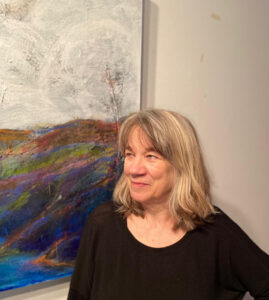
Atrayee: How did painting happen?
Cynthia: I was lucky enough to grow up in a household that supported and practiced the arts; my mom was an artist. I went to elementary school at a time when art was still a valuable part of the curriculum. While growing up, my refrigerator door was the proverbial art gallery! In college, I took life drawing, and black and white photography while focusing on education. These were the key components in starting my own art practice.
However, my first true passion in art was kindled after college when I did a several-year-long ceramic apprenticeship with master potter, J.T. Abernathy in Ann Arbor, Michigan. Years later I shifted from 3D art to 2D where my passion currently lies and remains. I went back to school to study painting at the University of Washington.
Today my 2D practice seems to be two-pronged—mixed media diptychs that contrast color with black and white, and pair with abstract versus realistic art, and a second body of work (especially during these years of the pandemic) reflecting a more traditional return to nature, landscapes and floral.
Atrayee: Speaking of nature, it seems to be an integral part of your work. What makes you keep going back to it?
Cynthia: It is a very strong calling for me, I never tire of it . . . some have said we paint nature to pay honor, to open others’ eyes to the beauty around them, to give a nod to the pressing issues of climate change in our natural world, to show the connection between humans and their world. Nature in artwork can make us feel more connected to our world. I have heard artists say when you paint it you feel it . . . other artists say it is a way of reminding people there is still beauty in our world. It is there and it is compelling.
Atrayee: How do you choose your subjects? Where do you look for inspiration?
Cynthia: I am so lucky to live in an amazing area of the country. The Pacific Northwest is a never-tiring source of inspiration for my work. Its mountains, ocean, flora, and fauna constantly find their way into my work. I most often work with nature, be it in an abstract form or realistic form—I find it inspiring.
Atrayee: The Pacific Northwest is beautiful indeed. Is Seattle or the Pacific Northwest region represented in any of your works in terms of culture?Cynthia: Culturally, Seattle is amazing for the arts. Seattle’s art scene is vibrant. With a reputation as a great art city, it is rich not only in the classics like dance, theater, and the symphony, but it is especially bountiful in the fine arts area. The creative community has a reputation for innovation and new approaches. A vital influence on the contemporary art scene in the Pacific Northwest for over the past 35 years has been COCA—the Center on Contemporary Art. COCA acts as a catalyst and forum for the advancement, development and understanding of contemporary art in the Northwest. Of course, another very strong presence in the Seattle art scene has been SAM—the Seattle Art Museum. SAM owns and operates three separate facilities: the museum, the Asian Art Museum, and the fabulous Olympic Sculpture Park. SAM houses over 25,000 works in total and works hard at making art accessible to Seattle residents.
The gallery scene is vibrant with most of the neighborhoods hosting monthly art walks which are generously supported by Seattleites.
Seattle also hosts the annual “Seattle Art Fair,” a huge yearly one-of-a-kind weekend-long exhibit hosting the best in modern and contemporary art and showcasing the vibrant art community of the Pacific Northwest. The fair brings together the region’s stronger collector base, local, national, and international galleries, museums, and institutions. Since 2015, galleries from Paris, Cologne, New York, Seoul, Los Angeles, Tokyo and more have been represented.
Atrayee: Tell us a bit about your medium. Why mixed media?
Cynthia: I enjoy mixing it up and I enjoy contrast. I often will create diptychs where half of the piece is a painting or a quick paint sketch, and the other is a print; I like contrasting the soft fluid lines of painting with the crisp edges found in prints. I often mix up my papers as well—if working on a diptych, half maybe on a paper (my new favorite) called “yupo” paper; it is a slick smooth paper much like vellum where the paint slips and slides and can be a little unpredictable. I love seeing the yupo surface next to the more traditional, thick, and heavy watercolor or print paper.
Atrayee: Can you please walk me through your process?
Cynthia: The images featured here in The Antonym are primarily paintings and done on paper. I use both standard acrylic paints, and also of late I have been using latex house paint! I find the latex paint to be very “wet,” thin, stringy, and fluid. In combination with the heavier-bodied acrylic paint, it is a busy contrast. I also use a fair amount of India ink in my work. I like bamboo brushes and sometimes I will use cake decorating tools when wanting to put texture into some of the thicker paints—it can be reminiscent of frosting a cake! I frequently reuse canvas, board, or paper. So many of these paintings have a history underneath and act as a kind of underpainting which can add a depth to the work.
I generally work on several paintings at one time. These florals were all done about the same time, and most of the florals are painted quickly with some or many layers and completed over several days.
Atrayee: What is the most challenging part of painting for you—deciding on what to say, how to say it, or is there something else?
Cynthia: Sometimes the limitations of my studio space (my studio is small!) can prove to be a challenge. If I am wanting to work large (for me 6ft. x 4ft. is large) and because I like to work on several paintings at a time, it can be a challenge to even physically arrange how to set up my painting area. So, my studio keeps expanding . . . I now have changed my foyer to a painting annex; it’s one place where I can hang some canvases up on the wall and paint right there . . . my bedroom has become the area where I do all my printing, and my studio can suffice for anything with paint and canvas and paper.
Atrayee: Who are your biggest influences?
Cynthia: I will always be enamored by the work of clay artist J.T. Abernathy, master artist/living legend from Ann Arbor, Michigan. JT is now 99 and still making pottery! His work is housed in 23 museums across the United States and Canada. A world renowned potter, JT had a huge influence on my ceramics, and his inspiration continues today in my painting and drawing. Even though for the past several decades I have been working in 2D, my personal art now revolves around drawing, painting, and printmaking. The passion, sensitivity, and devotion that I witnessed in JT and adopted as my own while working with him stays with me no matter what medium I work in. He taught me a way of thinking, a way of appreciating art and life.
I received my BFA in painting from the University of Washington and was privileged to study with Mr. Michael Spafford. Mr. Spafford said of his own work, “Basically my intelligence as an artist is reactive. I had one idea in 1958 and I’ve been reacting to that same idea ever since.” I believe many of us do this in our art; we may keep revisiting some of the same art themes and those can stretch out over a lifetime. Mr. Spafford taught with an acceptance and encouraged a sense of that that has stayed with me both in my own art and my teaching.
A third key influence for me was growing up with a mother who was an artist and art instructor. Art was a very big part of her life and consequently of mine. Ruth Carol Yatchman worked in all the painting mediums and clay but became best known for her work as a porcelain painter. She was a huge admirer and prolific painter of flora and fauna. In the “China painting” tradition, Ruth Yatchman worked on fine white porcelain using a series of overglazes fired in multiple layers at relatively low temperatures (1112-1556F). The medium is akin to watercolor but done on very fine porcelain, so there is an added translucency, smoothness, and delicacy to the art. Her immersion in her art and her enthusiasm was contagious and interestingly enough as I go forward in my art career, I find myself visiting some of her favorite subject, florals!
Atrayee: So, you learned from the masters and were a ceramicist yourself. How did the switch happen? Do you still work with ceramics?
Cynthia: I moved from the Midwest to the West Coast decades ago and with that physical move came a shift in my artmaking. I went to art school here in Seattle and worked in depth on painting. I rarely do ceramics these days, but I do keep my hand in it a bit by teaching some clay classes, even though I don’t run a studio of my own in clay anymore . . . the most recent very fun and meaningful clay experience for me is teaching a clay class for parents and their two to four-year-old toddlers. It’s wonderful to see the moms and dads working collaboratively with their young children, and seeing these toddlers and preschooler have this amazing sensory and artistic experience and sharing this with their parents and other families.
Atrayee: Is there anything in particular that your art represents?
Cynthia: No, my art mainly relies on the viewer to bring their own vision and life experiences in their interpretation of what they view.
Atrayee: Tell us about your experience as an art instructor. Does it influence your creative work? If so, how?
Cynthia: These days I am teaching less but my most recent classes have been the clay classes I mentioned. I am also teaching some beginners’ classes at my local senior center. I have taught classes in pastels, watercolors, colored pencils, etc.—it’s been quite lovely. Many of these students are revisiting art after decades of working now that they finally have time to explore more in their retirement, they choose to reignite a passion from their youth. I also have students who are accomplished and have had a lifetime of artmaking and those who are picking up a paintbrush for the very first time. It does influence my work in that it is so joyful to see such passion in action, and bravery in trying new things; their enthusiasm is contagious.
Atrayee: What do you enjoy doing when the painter in you wants to take a break?
Cynthia: I enjoy walking, being out in nature, cooking, and spending time with family and friends.
Here are some of the works from Cynthia shared with The Antonym:

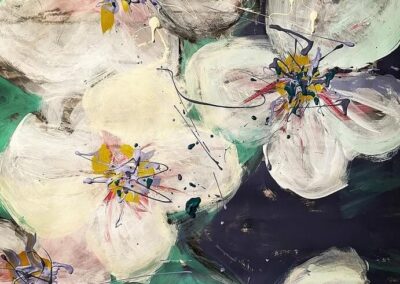
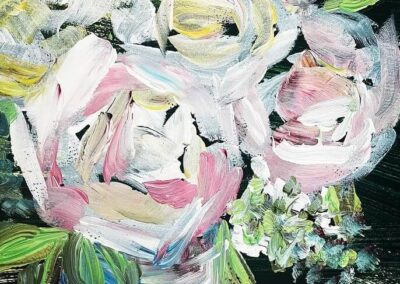
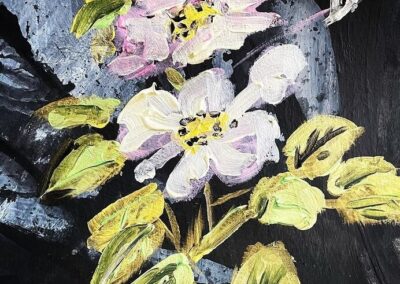
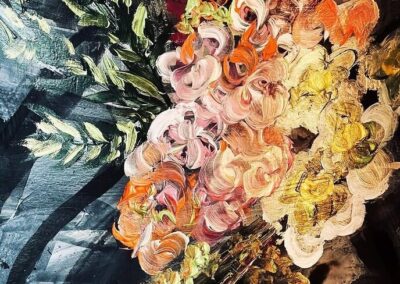
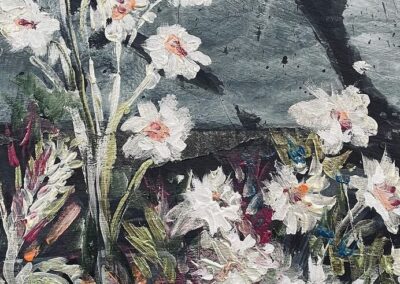
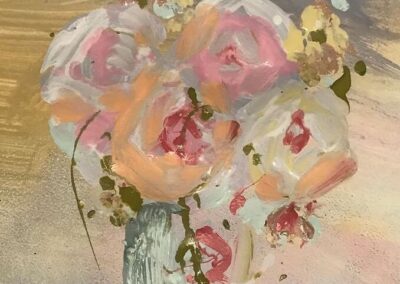
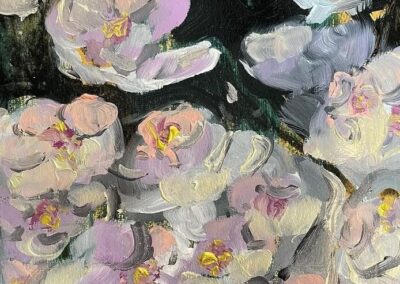
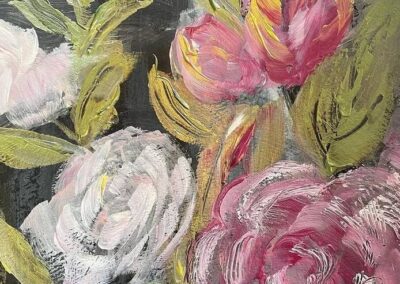
























0 Comments